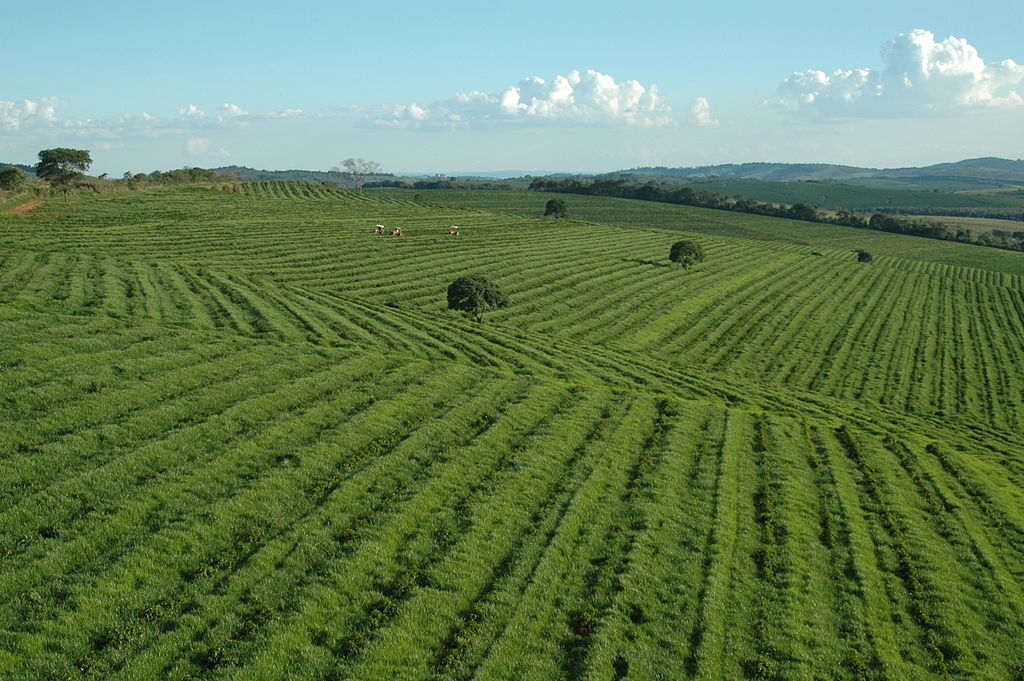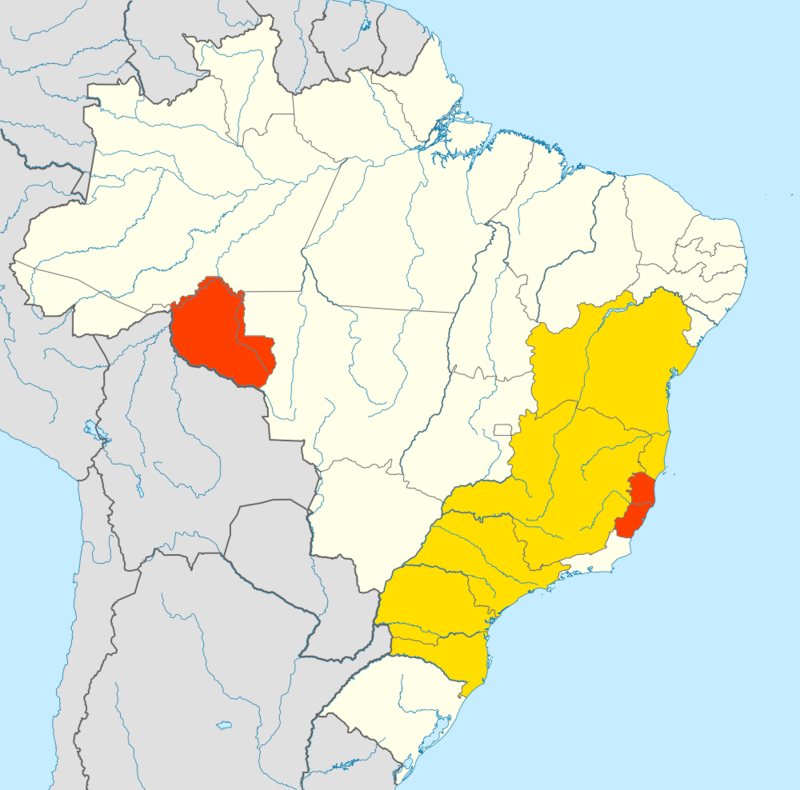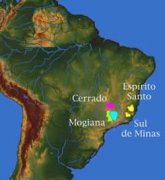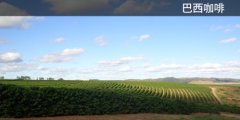Brazilian Coffee Industry Encyclopedia introduction to the production, Export and sales of Brazilian Coffee

For professional baristas, please follow the coffee workshop (Wechat official account cafe_style)
Brazil's coffee industry accounts for about 1/3 of the world's total output and is currently the world's largest coffee producer. Coffee plantations in Brazil cover a total area of about 27000 square kilometers, mainly in Minas Gerais, Sao Paulo and Parana in southeastern Brazil, because the environment and climate of these states provide ideal growth conditions for coffee beans.
Production
In the past 150 years, Brazil has been the world's largest coffee producer, accounting for about 1/3 of the world's coffee production. In 2011, Brazil remained the world's largest coffee producer, followed by Viet Nam, Indonesia and Colombia [2]; total coffee production in Brazil in that year was 2.7 million tons, twice that of Viet Nam [3]. About 3.5 million people in Brazil are engaged in coffee farming, mainly in rural areas [4].
There are about 220000 coffee plantations in Brazil [5], and coffee plantations in the country cover a total area of about 27000 square kilometers [4], mainly in Minas Gerais, Sao Paulo and Parana in southeastern Brazil, because the environment and climate of these states provide ideal conditions for the growth of coffee beans; Minas Gerais accounts for about half of the national coffee production [6]. Most plantations harvest during the dry season from June to September. In most countries, small fruit coffee beans are treated with "washed coffee" technology, but in Brazil, almost all coffee is treated with "air-dried coffee" [8], coffee beans are dried in the sun for 8-10 days [9], and then they are classified and packaged [10].

Export and sales
In the 1850s and 1960s, Brazilian coffee exports accounted for more than 50% of total exports of all goods [11] and 63.9% [12] in 1950, but this percentage began to decline in the 1960s because of the expansion of the market for export goods. In 1980, the ratio of Brazilian coffee exports to total exports of all goods fell to 12.3% [12] and only 2.5% in 2006 [4].
Brazil itself is the world's second-largest consumer of coffee and is expected to overtake the United States by the mid-2010s [13]. Brazil ranks 14th in per capita coffee consumption in the world [14].
In Brazil, the import of certain types of coffee beans into the country will be taxed by 10-16% [15]; the export of unprocessed coffee to the United States, the European Union and Japan will be duty-free [16]. However, the tax rate for the export of processed coffee to the European Union is 7.5%, to Japan is 10%, and to the United States is duty-free [16].
Referenc
Jump to ^ Neilson & Pritchard 2009, page 102
Jump ^ Coffee: World Markets and Trade (PDF). Foreign Agricultural Service Office of Global Analysis. United States Department of Agriculture. December 2009 [26 March 2010].
Jump ^ Food and Agricultural commodities production. Food and Agriculture Organization. [28 April 2013].
^ Jump to: 4.0 4.1 4.2 Souza 2008, page 225
Jump ^ Waller,Bigger & Hillocks (2007), page 22
Jump to ^ Crocitti & Vallance 2011, page 22
Jump to ^ Souza 2008, page 13
Jump to ^ Varnam & Sutherland 1994, page 212
Jump to ^ Varnam & Sutherland 1994, page 214
Jump ^ Belitz,Grosch & Schieberle (2009), page 939
Jump to ^ Abreu 2004, page 10
Jump to: 12.012.1 Fausto 1999, page 324
Jump ^ Isis Almeida. Brazil May Become World's Biggest Coffee Consumer in Three Years. Bloomberg L.P. 6 March 2012.
Jump to ^ Daviron & Ponte 2005, page 74
Jump ^ Statistics on coffee: Brazil (2011) (PDF). International Coffee Organization. [23 April 2013].
Jump to: 16.016.1 OECD 2005, pages 168-9
Important Notice :
前街咖啡 FrontStreet Coffee has moved to new addredd:
FrontStreet Coffee Address: 315,Donghua East Road,GuangZhou
Tel:020 38364473
- Prev

Characteristics of Brazilian Coffee beans introduction of planting and picking methods of Brazilian Coffee
Professional baristas exchange please follow the coffee workshop (Wechat official account cafe_style) Brazilian coffee characteristics of Brazilian coffee generally refers to the coffee produced in Brazil. There is a wide variety of Brazilian coffee, the vast majority of which are unwashed and sun-dried, classified according to the name of the state of origin and the port of transport. Brazil has 27 states and 17 states produce coffee, but 4 of them
- Next

How to make Brazilian coffee: from a seed to a cup of coffee
The exchange of professional baristas please follow the coffee workshop (Wechat official account cafe_style) about coffee production. The main consideration is ① production, ② diseases and insect pests, ③ quality, in terms of agricultural stability, the first priority is production. In addition, 80% of Brazilian coffee is dried, and the remaining 20% is semi-dried and washed. Its coffee taste characteristics are different, but high.
Related
- Detailed explanation of Jadeite planting Land in Panamanian Jadeite Manor introduction to the grading system of Jadeite competitive bidding, Red bid, Green bid and Rose Summer
- Story of Coffee planting in Brenka region of Costa Rica Stonehenge Manor anaerobic heavy honey treatment of flavor mouth
- What's on the barrel of Blue Mountain Coffee beans?
- Can American coffee also pull flowers? How to use hot American style to pull out a good-looking pattern?
- Can you make a cold extract with coffee beans? What is the right proportion for cold-extracted coffee formula?
- Indonesian PWN Gold Mandrine Coffee Origin Features Flavor How to Chong? Mandolin coffee is American.
- A brief introduction to the flavor characteristics of Brazilian yellow bourbon coffee beans
- What is the effect of different water quality on the flavor of cold-extracted coffee? What kind of water is best for brewing coffee?
- Why do you think of Rose Summer whenever you mention Panamanian coffee?
- Introduction to the characteristics of authentic blue mountain coffee bean producing areas? What is the CIB Coffee Authority in Jamaica?

